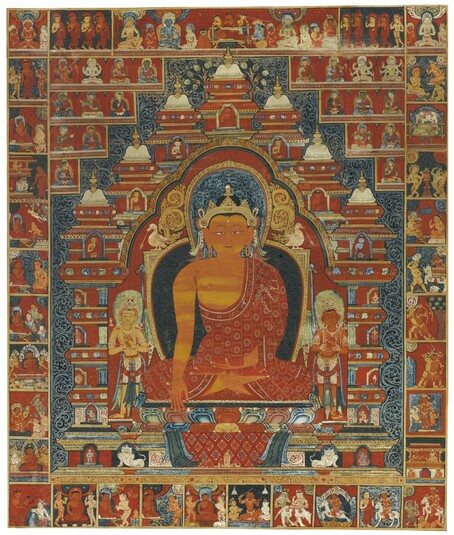
Item: Shakyamuni Buddha - Life Story (Single Composition)
| Origin Location | Nepal |
|---|---|
| Date Range | 1300 - 1399 |
| Lineages | Buddhist |
| Material | Ground Mineral Pigment on Cotton |
| Collection | Private |
Classification: Person
Appearance: Buddha
Gender: Male
Shakyamuni Buddha (Tibetan: sha kya tu pa, sang gye. English: the Enlightened One, Sage of the Shakya Clan), founder of Buddhism. (See another Nepalese composition with an almost identical iconographic program).
The composition elements of the painting are the two relatively distinct spaces. The first space is the central square created by the horizontal and vertical grid lines. The second space is the outer registers at the top, bottom and two sides.
Composition Elements: - Inner Enclosure - Outer Register
The iconographic program of the painting has three main elements. The first element is Shakyamuni Buddha with two retinue figures. The second element is the arrangement of the Sixteen Elders at the upper right and left of the inner square enclosure. The third element is the inclusion of the life story of the Buddha placed as a single row of registers at the top, bottom and sides of the composition. The visual narrative begins at the top right corner and then proceeds clockwise to the top central vignette with the passing of the Buddha into parinirvana.
Iconographic Program: - Shakyamuni Buddha & Retinue - Sixteen Elders - Buddha Life Story
Grouped with the Elders on the viewer's upper left side are two deities, orange coloured Prajnaparamita with four arms and Chaturbhuja Lokeshvara, white in colour. Seated with the Elders on the other side are two unidentified white deities, seated, with multiple arms.
Formal in appearance, Shakyamuni Buddha typically gazes forward with partially closed eyes and the blue-black hair on the head is piled in a tuft on top with a single ornament adorning the crown. Between the eyebrows and slightly above is a white dot (urna) and adorning the neck are three curved horizontal lines. The earlobes are long and pierced. With the right arm bare the right hand is extended across the knee in the earth touching gesture (mudra). The left performs the gesture (mudra) of meditation - palm upward in the lap. Across the left shoulder is a coloured patchwork robe and a similar garment covers the lower body. The legs are folded in vajra posture.
This image of Shakyamuni depicts him wearing an elaborate crown with short ribbons at the sides. Standing on his proper right side is Maitreya Bodhisattva, yellow in colour. Standing on the proper left side is Manjushri Bodhisattva, orange in colour. Both are identified by the presence of their unique attributes of a water vase and a sword. All three figures are placed before a large temple architectural structure with seven roof peaks and framing seven small buddha figures each in their own niche. At the lower sides of the architectural structure are four deity figures with blue Nila Achala and Panjara Mahakala on the proper right side and white Sita Achala and Shri Devi on the left side.
"Born in the Shakya race through skillful means and compassion; destroying the army of Mara who was unable to be destroyed by others; with a body radiant like a mountain of gold. Homage to you, King of the Shakya." (Tibetan liturgical verse).
A Buddha is known for having thirty-two major and eighty minor distinguishing physical characteristics (marks) based on the Indian cultural description of a Universal Monarch (Chakravartin) - the highest and most developed male form. Only a few of these 112 marks are depicted in art such as the ushnisha on the top of the head, the urnakesha between the eyes, three curved horizontal lines on the neck, a Dharma Wheel impression on the palms of the hands and soles of the feet.
Vajra Posture: a Buddhist term referring to a seated position where the feet are placed sole up on the thigh of the opposite leg; right over left. In the West this posture is almost universally referred to as the lotus posture because that is the name used by the major Hindu traditions and in Hatha Yoga, subjects which are generally more familiar to Western audiences. The location of the Buddha's enlightenment in India, now called Bodhgaya, is called Vajrasana in Buddhist literature. The posture the Buddha sat in while reaching enlightenment is the vajra posture, and the highest meditation (samadhi) that is accomplished on reaching Buddhahood, in this vajra location and seated in vajra posture, is vajra samadhi.
Jeff Watt 9-99 [updated 8-2019]
Shakyamuni Buddha, 释迦牟尼佛:, ཤཱཀྱ་ཐུབ་པ། Painting (Masterworks)
Subject: Torana, Shakyamuni Buddha (Early Animal Depictions)
Shakyamuni Buddha & the Sixteen Elders (Single Composition)
Shakyamuni Buddha: Life-story (Single Composition)
Painting: Copies & Facsimiles
Shakyamuni Buddha: Early Paintings
Shakyamuni Buddha: Painting Comparison (Nepalese Style Life Story)
Shakyamuni Buddha: Life-story (Register Composition)
Nepal: Masterworks (Painting)









